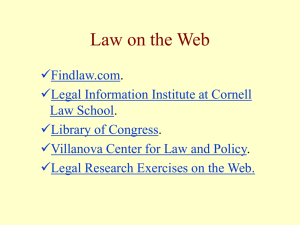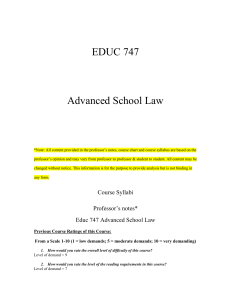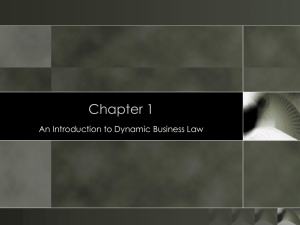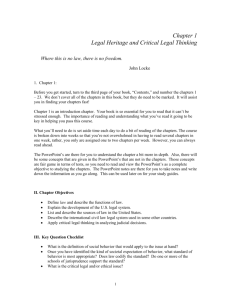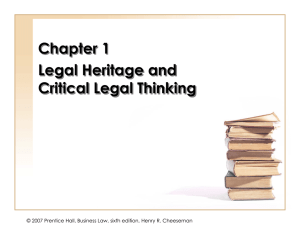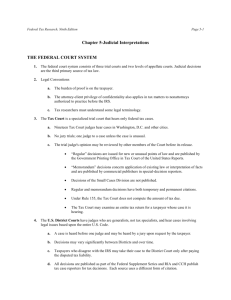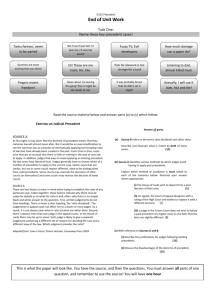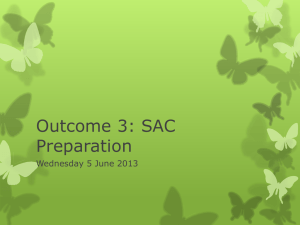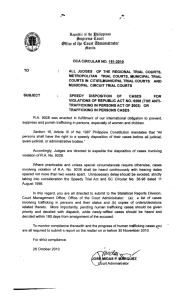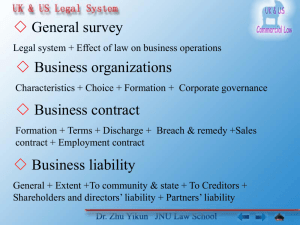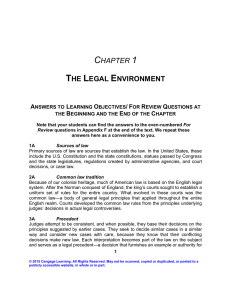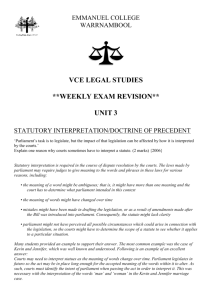Chapter 1– Law as the Foundation of Business Those entering the
advertisement
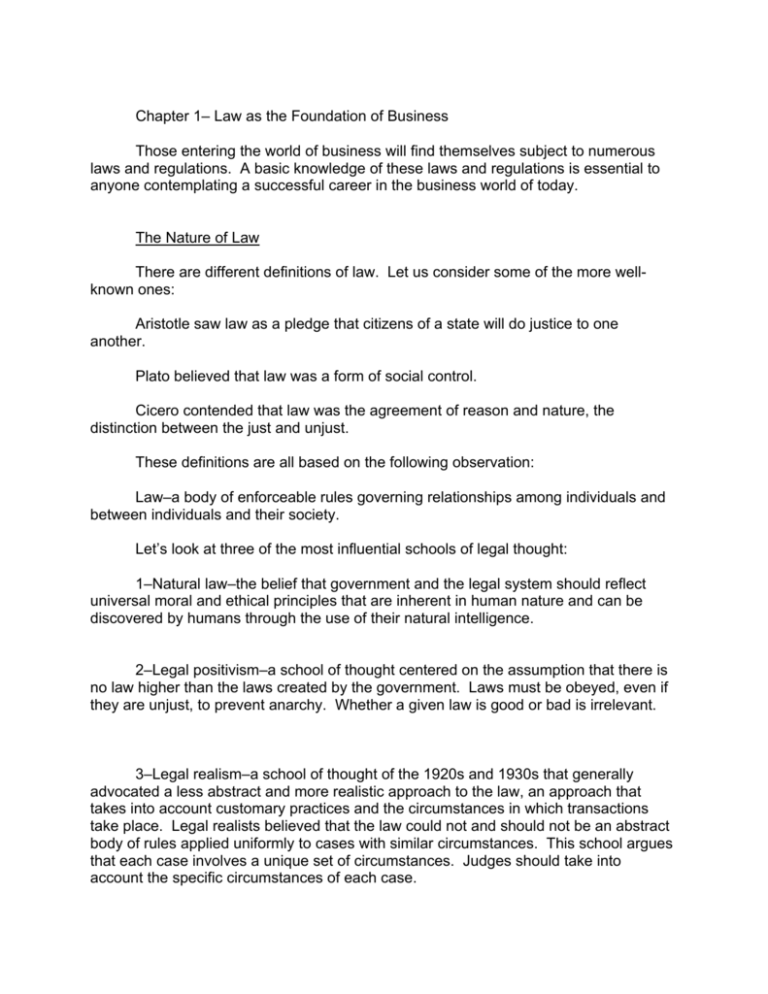
Chapter 1– Law as the Foundation of Business Those entering the world of business will find themselves subject to numerous laws and regulations. A basic knowledge of these laws and regulations is essential to anyone contemplating a successful career in the business world of today. The Nature of Law There are different definitions of law. Let us consider some of the more wellknown ones: Aristotle saw law as a pledge that citizens of a state will do justice to one another. Plato believed that law was a form of social control. Cicero contended that law was the agreement of reason and nature, the distinction between the just and unjust. These definitions are all based on the following observation: Law–a body of enforceable rules governing relationships among individuals and between individuals and their society. Let’s look at three of the most influential schools of legal thought: 1–Natural law–the belief that government and the legal system should reflect universal moral and ethical principles that are inherent in human nature and can be discovered by humans through the use of their natural intelligence. 2–Legal positivism–a school of thought centered on the assumption that there is no law higher than the laws created by the government. Laws must be obeyed, even if they are unjust, to prevent anarchy. Whether a given law is good or bad is irrelevant. 3–Legal realism–a school of thought of the 1920s and 1930s that generally advocated a less abstract and more realistic approach to the law, an approach that takes into account customary practices and the circumstances in which transactions take place. Legal realists believed that the law could not and should not be an abstract body of rules applied uniformly to cases with similar circumstances. This school argues that each case involves a unique set of circumstances. Judges should take into account the specific circumstances of each case. Common Law Tradition Because of our colonial and historical heritage, much of American law is based on the English legal system. King’s courts were used by the Normans to establish a uniform set of rules for the country as a whole. What developed was the common law. Common law–that body of law developed from custom or judicial decisions in English and American courts, not attributable to a legislature. Courts developed the common law rules from the principles underlying judges’ decisions in actual legal controversies. Judges attempted to be consistent and whenever possible, they based their decisions on the principles suggested by earlier cases. Precedent–a court decision that furnishes an example or authority for deciding subsequent cases involving identical or similar facts. Stare decisis–a common law doctrine under which judges are obligated to follow the precedents established in prior decisions. Stare decisis makes the law more stable and predictable. Stability and predictability reduce risk in business transactions. For example, if the Supreme Court of Florida (the state’s highest court) has ruled in a certain way on an issue, that decision will control the outcome of future cases on that issue brought before state courts in Florida. Binding authority–any source of law that a court must follow when deciding a case. Binding authorities include constitutions, statutes, and regulations that govern the issue being decided, as well as court decisions that are controlling precedents within the jurisdiction. Frequently, courts make comments on matters not necessary to a decision reached. These comments are referred to as dicta. They are not precedents that courts will be required to follow. They may be followed if they are just and sound. Sometimes a court will depart from the rule of precedent if it decides that a given precedent should no longer be followed. In Brown v. Board of Education of Topeka, the U.S. Supreme Court overturned precedent when it concluded that separate educational facilities for whites and blacks were inherently unequal. Sometimes there is no precedent within a jurisdiction on which to base a decision. A court may look to precedents set in other jurisdictions or states for guidance. Persuasive authority–any legal authority or source of law that a court may look to for guidance but on which it need not rely in making its decision. Equitable Remedies and Courts of Equity In law, a remedy is the means given to a party to enforce a right or to compensate for the violation of a right. When an injured party wanted a remedy other than economic compensation, the courts of law in England could do nothing. In medieval England, when individuals could not obtain an adequate remedy at law, they petitioned the king for relief. Most of these petitions were decided by an adviser to the king called the chancellor. When the chancellor thought that the claim was a fair one, new and unique remedies came into being, and eventually courts of equity were established. Remedies granted by these courts were called remedies in equity. Plaintiff– Defendant– Today, in most states, the courts of law and equity are merged and the distinction between the two courts has largely disappeared. Over time a number of equitable principles and maxims have developed. These include: Sources of American Law Primary sources of law include: constitutional law– statutory law– Differences among state laws were particularly notable in the 1800s, when conflicting state statutes frequently made the rapidly developing trade and commerce among the states difficult. To counter these problems, a group of legal scholars formed the National Conference of Commissioners on Uniform State Laws in 1892 to draft uniform statutes for adoption by the states. Uniform Commercial Code (UCC)-- Administrative law– Administrative agency– Because Congress cannot possibly oversee the actual implementation of all the laws it enacts, it must delegate such tasks to others, particularly when the issues relate to highly technical areas, such as air and water pollution. Congress creates an administrative agency by enacting enabling legislation, which specifies the name, composition, purpose, and powers of the agency being created. For example, the Federal Trade Commission was created in 1914 by the Federal Trade Commission Act (which prohibits unfair and deceptive trade practices). Sometimes a court will evaluate a law passed by Congress or a legislature and find it to be unconstitutional. This is referred to as judicial review. Judicial review– One of the major functions of an administrative agency is rulemaking. Rulemaking– The most common rulemaking procedure involves three steps; 1–the agency must give public notice of the proposed rulemaking proceedings, where and when the proceedings will be held, the agency’s legal authority for the proceedings, and the terms or subject matter of the proposed rule 2–the agency must allow ample time for interested parties to comment in writing on the proposed rule 3–the drafting of the final version and the publication of the rule The Relationship Between The Common Law and Statutory Law There is a significant overlap between statutory law and case law. Many statutes codify existing common law rules. Courts often rely on the common law as a guide to interpreting statutes. Classifications of Law The huge body of law may be broken down according to several classification systems. One classification divides law into substantive law and procedural law. Substantive law– Procedural law– Another classification system divides law into civil law and criminal law. Civil law– Criminal law– Other classification systems divide law into federal law and state law, private law (dealing with relationships between persons) and public law (addressing the relationship between persons and their government). National and International Law Although the focus of this course is American law, increasingly business is this country is engaging in transactions that extend beyond our national borders. In these situations, the laws of other nations or the laws governing relationships among nations may come into play. National law– Basically, there are two legal systems in today’s world. One of these systems is the common law. The other system is based on Roman civil law or code law. Civil law– Basically, those countries that were once colonies of the United Kingdom retained their UK common law heritage after they achieved independence. The civil law system, which is followed in most of the continental European countries, was retained in the Latin American, African, and Asian nations that once were colonies of the continental European countries. International law– Treaty--

